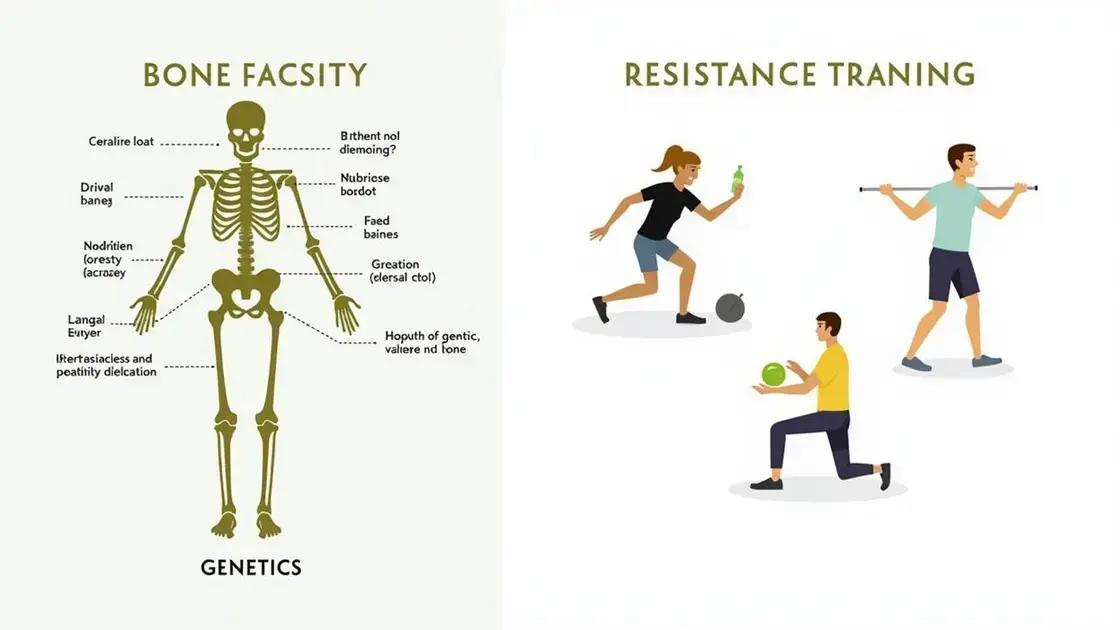Resistance training is essential for improving bone density, as it strengthens bones and reduces the risk of osteoporosis. Effective exercises include weightlifting, bodyweight exercises, and resistance bands, and incorporating these into a consistent routine can enhance bone health significantly.
Resistance training is a powerful tool for enhancing bone density and overall strength. By engaging in targeted exercises, individuals can improve their bone health, reduce the risk of fractures, and maintain mobility as they age. In this article, we will delve into the importance of bone density, the benefits of resistance training, effective exercises, and tips for incorporating these practices into your fitness routine.
Understanding Bone Density and Its Importance

Bone density is a critical aspect of overall health and well-being. It refers to the amount of mineral matter per square centimeter of bone. High bone density means that bones are strong and less likely to fracture. Conversely, low bone density can lead to osteoporosis, a condition where bones become weak and brittle.
Understanding the importance of bone density is vital, especially as we age. Factors such as genetics, nutrition, and lifestyle choices play significant roles in determining bone density levels. For example, calcium and vitamin D are essential nutrients that contribute to the growth and maintenance of healthy bones.
Why High Bone Density Matters
Having a high bone density provides several benefits. It helps in protecting vital organs, supports movement, and reduces the risk of injuries. Strong bones also play a part in maintaining a healthy posture and minimizing back pain.
As we age, our bone density naturally declines, particularly after menopause for women. Thus, it’s crucial to take preventive measures early on to maintain optimal bone density. Engaging in regular physical activity, especially resistance training, has proven to be effective in promoting bone strength.
Factors Affecting Bone Density
Bone density can be influenced by various factors, including:
- Genetics: A family history of osteoporosis can increase your risk.
- Diet: A diet rich in calcium and vitamin D is essential for strong bones.
- Exercise: Weight-bearing and resistance exercises contribute positively to bone density.
- Lifestyle: Smoking and excessive alcohol consumption can negatively affect bone health.
Monitoring bone density can help in early detection of potential issues. Bone density tests, typically performed in clinics, are advised for individuals at higher risk, ensuring proactive management of bone health.
Key Benefits of Resistance Training for Bones

Resistance training offers numerous benefits for bone health. By applying stress to bones through weight and resistance exercises, we can stimulate bone growth and increase density. Below are the key benefits of incorporating resistance training into your fitness routine:
1. Increases Bone Density
Regular resistance training effectively increases bone density. This is essential to prevent osteoporosis, especially in older adults. When bones experience tension, they respond by becoming denser and stronger over time.
2. Enhances Muscle Strength
Resistance training not only strengthens bones but also builds muscle mass. Strong muscles help support and protect the bones, reducing the risk of fractures during falls or accidents.
3. Improves Balance and Coordination
Engaging in resistance exercises helps improve balance and coordination. Better balance decreases the likelihood of falls, which is vital for preserving bone health as we age.
4. Facilitates Functional Movements
Incorporating resistance training into your routine enhances everyday functional movements. It helps you perform daily tasks with ease, whether lifting grocery bags or climbing stairs, while also reducing the risk of injury.
5. Boosts Metabolism
Resistance training increases metabolism by building muscle mass. A higher metabolic rate contributes to better weight management, which is essential for overall health and well-being.
Overall, the key benefits of resistance training for bones make it a vital component of a healthy lifestyle. People of all ages should consider adding it to their fitness journey to promote better bone health.
Effective Resistance Exercises for Better Bone Density

To achieve better bone density, incorporating effective resistance exercises into your routine is essential. These exercises help to create stress on the bones, prompting them to strengthen. Below are some of the most effective resistance exercises to enhance bone density:
1. Weightlifting
Weightlifting is one of the best ways to improve bone strength. Use free weights like dumbbells or barbells to perform exercises such as squats, deadlifts, and bench presses. Start with lighter weights and gradually increase them as your strength improves.
2. Bodyweight Exercises
Bodyweight exercises like push-ups, lunges, and squats are also effective. They use your body’s weight as resistance. Aim for higher repetitions to strengthen bones and muscles.
3. Resistance Bands
Resistance bands are great for beginners. They can help you perform a wide range of exercises, such as band pulls and leg extensions. They provide consistent tension throughout the movement, which helps stimulate bone growth.
4. Pilates
Pilates can enhance core strength and overall stability. Certain Pilates exercises, like the shoulder bridge or leg circles with resistance, can provide the necessary resistance to improve bone density.
5. Weight-Bearing Activities
Including weight-bearing activities in your routine, such as jogging, dancing, or climbing stairs, is beneficial. These activities force you to work against gravity and promote healthy bone density.
Always consult with a healthcare professional or a fitness trainer to ensure you are using the right technique and to avoid injury. By incorporating these exercises into your fitness routine, you can effectively enhance your bone density.
Tips to Incorporate Resistance Training into Your Routine

Incorporating resistance training into your routine can greatly enhance your bone density and overall fitness. Here are some practical tips to help you get started:
1. Set Realistic Goals
Begin by setting achievable goals. Focus on specific outcomes, such as increasing the weight you lift or completing more repetitions. These goals will help you stay motivated and track your progress.
2. Start Slowly
If you’re new to resistance training, begin with light weights or bodyweight exercises. This approach allows your body to adapt gradually and helps prevent injuries.
3. Create a Schedule
Designate specific days and times for your resistance training workouts. Consistency is crucial for improving bone density. Aim for at least two to three sessions per week, varying the exercises to target different muscle groups.
4. Ensure Proper Technique
Using the correct form during exercises is essential for effective training and injury prevention. Consider working with a certified trainer, especially when starting, to learn proper techniques.
5. Mix It Up
Incorporate a variety of exercises in your routine. Use free weights, resistance bands, and machines to keep things interesting and work different muscle groups effectively.
6. Listen to Your Body
Pay attention to how your body feels during and after workouts. If you experience pain or discomfort, it may be a sign to modify your routine or rest. Always prioritize your well-being.
7. Stay Hydrated and Eat Well
Proper nutrition and hydration are vital for recovery and performance. Ensure you consume a balanced diet with adequate protein to support muscle repair and growth.
8. Track Your Progress
Keeping a workout log can help you monitor your improvements. Note the weights you lift, the number of sets and reps, and any changes in how you feel. This record will help you stay motivated.
By following these tips, you can successfully incorporate resistance training into your routine, ultimately leading to better bone density and physical health.
Enhance Your Bone Density with Resistance Training
In conclusion, incorporating resistance training into your routine is vital for improving bone density and overall physical health. By understanding the importance of bone density, the benefits of resistance training, and the various effective exercises available, you can create a lasting impact on your well-being.
Remember to set realistic goals, start slowly, and ensure you maintain proper technique. It’s essential to remain consistent, mix up your exercises, and listen to your body as you progress.
With dedication and the right approach, resistance training can be a powerful ally in boosting your bone strength and achieving a healthier, more active lifestyle.
Don’t wait—start your resistance training journey today!
FAQ – Frequently Asked Questions about Resistance Training for Bone Density
What is resistance training?
Resistance training is a form of exercise that involves working against a force to improve strength, muscle tone, and bone density.
How does resistance training improve bone density?
Resistance training creates stress on bones, which stimulates bone growth and increases density, reducing the risk of fractures.
What are some effective resistance exercises for bone density?
Effective exercises include weightlifting, bodyweight exercises, resistance band workouts, and weight-bearing activities like jogging or dancing.
How often should I do resistance training?
Aim for at least two to three sessions per week, targeting different muscle groups to promote overall bone and muscle health.
Is it essential to use proper technique in resistance training?
Yes, using proper technique is crucial to prevent injuries and maximize the effectiveness of your workouts.
Can beginners start resistance training?
Absolutely! Beginners should start slowly with lighter weights and bodyweight exercises to build strength and confidence.













